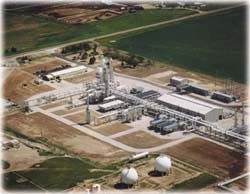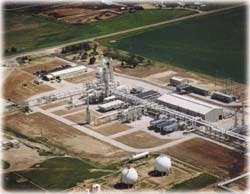New Hugoton gas plant starts up
Steve Ruehle, Lynn Coalmer
Amoco Corp.
Houston
The Jayhawk gas plant replaces two older, less-efficient plant's in the Kansas Hugoton field (Fig. 1; photographs courtesy of Douglas R. Childs, ABB Randall, Houston).
- Jayhawk's nitrogen-stripping tower is lowered into final position (Fig. 3; photographs courtesy of Douglas R. Childs, ABB Randall, Houston). [12,035 bytes]
- The plant's fractionation train and de-ethanizer and de-propanizer towers give the plant flexibility (Fig. 4; photographs courtesy of Douglas R. Childs, ABB Randall, Houston). [10,884 bytes]
- Residue compressors are equipped with 16,500-hp electric motors (Fig. 5; photographs courtesy of Douglas R. Childs, ABB Randall, Houston). [10,443 bytes]
- A single cold box (left) was finally deemed economical for the new plant (Fig. 6; photographs courtesy of Douglas R. Childs, ABB Randall, Houston). [13,473 bytes]
- Fractionated-propane storage holds product aimed at a local market (Fig. 7; photographs courtesy of Douglas R. Childs, ABB Randall, Houston). [8,993 bytes]
The plant's 450-MMcfd design processing capacity will accommodate substantially all of Amoco's proprietary production and an ever-increasing share of third-party production as proprietary volumes decline over time.
The plant is positioned to be a regional processing hub, not only for Hugoton gas, but for gas produced in Oklahoma, Colorado, and the Texas Panhandle.
Hugoton Jayhawk is designed to recover more than 80% of the C2 and essentially all of the C3+ components in a Y-grade NGL product stream of approximately 31,000 b/d (Fig. 2 [75,378 bytes]). Hugoton area gas contains about 0.4% helium, of which up to an estimated 98% is recovered in a product stream of approximately 700 MMscf/yr.
The plant operates in deep nitrogen rejection to reduce the nitrogen content from an inlet level of more than 15% to less than 3% in the residue gas. After product and inert shrinkage, the residue-gas stream contains about 360 MMscfd of 1,025-BTU/std. cu ft gas.
ABB Randall, Houston, was prime contractor with responsibility for engineering, procurement, fabrication, and construction of the plant, which is now one of the top five NGL-producing plants in the U.S.
Hugoton history
The Kansas Hugoton field was discovered in the early 1920s when shallow gas was encountered in the Chase series formation during exploration for oil in deeper zones. Little interest was shown in the gas until the late 1940s when, over the next 10 years, more than 3,000 wells were drilled.From 1970 to 1982, development of the deeper Council Grove gas proceeded steadily with about 2,000 wells being drilled. Since authorization was received for in-fill drilling in 1986, the industry has completed more than 2,760 new wells.
There are now a total of about 9,300 wells in the Hugoton field which have produced a cumulative 25 tcf of gas; more than 4 tcf of gas remain to be produced.
Most of the field's gas-gathering systems and gas-processing plants were constructed concurrent with field development. The Amoco-operated Ulysses gasoline plant is a lean-oil facility built in 1948. The plant was designed to recover and dehydrate a limited NGL product consisting of 30% of the C3 and most of the C4 and C5.
The Ulysses plant initially had a full-spectrum fractionation train, but recently produced only an HD-5 grade propane for local sales. Given the high inert content and lack of nitrogen-rejection capabilities, NGL recovery was limited to meet the residue-gas heating value contract specification of 925 BTU/std. cu ft.
The Warren-operated Jayhawk plant was built in 1962 by Cities Services Gas Co. The plant was built with nitrogen rejection and helium-recovery capabilities and, as such, was able to reprocess Ulysses' residue gas for recovery of the remaining C3+ NGL stream and the helium.
Additionally, the plant was positioned to process gas from other producers, including Cities Service's proprietary production.
Amoco had made several attempts in the past to gain control of its proprietary processing rights which would allow it to construct a new state-of-the-art cryogenic gas-processing plant to replace the older facilities. Amoco reached agreement with Williams Natural Gas Co. and Trident NGL Inc. wherein Amoco would construct, operate, and control the replacement facilities.
In replacing both plants, the Hugoton Jayhawk gas-processing plant eliminates double-plant operating costs and the relatively high ongoing maintenance and repair expense. The reduction of processing costs coupled with margins earned from deep C2 recovery were sufficient to justify the capital investment to construct new facilities.
Process design
The existing two plants had used water-cooling towers which consumed more than 1 million gpd.The use of aerial coolers and electric-drive compressors at the new plant eliminates the need for cooling water and preserves the resource for alternative uses. In addition to eliminating the need for cooling towers, the use of electric-drive compressors eliminates a source of air emissions, greatly simplifying the permitting process.
Residue gas will be delivered to Williams Natural Gas for transport to markets. The Hugoton Jayhawk gas-processing plant sits adjacent Williams' Hugoton compressor station in Grant County, Kan.
Gas to the plant inlet will come from the Amoco-operated Williams gas-gathering system, from Mobil Exploration & Producing U.S. Inc. and Oxy USA Inc.-owned gas-gathering systems, and from new gathering facilities as additional processing commitments are secured.
The Hugoton Jayhawk plant was designed for an inlet-gas capacity of 450 MMscfd. The gas stream must be conditioned for sale to meet pipeline hydrocarbon and water-dew point specifications. Williams has no total inert-content specification; it does require, however, a minimum gas-heating value of 950 BTU/std. cu ft.
The naturally occurring nitrogen content in Hugoton gas ranges from 14% to 21%. Even with the high inert content, the inlet NGL content of the gas stream exceeds 3.0 gpm and the inlet gross heating value is 1,000 BTU/std. cu ft.
However, absent nitrogen-rejection facilities, meeting the residue-gas heat content specification requires leaving a significant amount of recoverable NGL in the residue-gas stream. While only incidental amounts of C2 and C3 are recovered, C4 and C5 recovery is limited to a maximum of 70% without lowering the inert content of the residue gas.
Rejection of nitrogen (Fig. 3) to 3% accomplishes two objectives:
1. A deep cut of NGL is facilitated, while the residue-gas heating value is improved
2. Inert nitrogen (50
MMscfd) is removed from the downstream natural-gas distribution system, effectively increasing system capacity while lowering transportation-system operating costs.
The plant can recover C2 to a level exceeding 80% or reject C2 to a level of less than 10%, depending on product margins. C3 recovery exceeds 99% level while operating in C2 recovery and is 96% while operating in C2 rejection (Fig. 4).
In both modes of operation, the recovery of C4+ approaches 100%. The design level of helium recovery is 98% in both C2 recovery and rejection modes. Hugoton area gas is relatively rich in helium content, averaging more than 0.4%. While this is a seemingly small amount of helium, the market value of crude helium is such that its recovery is important to project economics.
A portion of the NGL is fractionated to produce HD-5 grade propane for the local markets. The balance of the NGL is delivered to Conway, Kan., as a Y-grade raw mix via connections to Koch Hydrocarbon Co. and Mapco Inc. The crude helium product stream, containing 65% helium and 35% nitrogen, is delivered to Praxair Inc. for refining into purified helium or injection into the Bureau of Land Management crude helium storage reservoir.
A small portion of liquefied nitrogen is delivered to Praxair for use as a refrigerant in the helium refining process.
Major decisions
To balance plant functionality with capital budget constraints, the construction team made many design decisions to optimize the full-cycle value of the asset. Some of the major decisions follow:Gas turbines vs. electric motors. A full-cycle, after-tax economic analysis led to the decision to install electric motors instead of gas-turbine drivers on all compressors (Fig. 5).
The lower capital cost, higher reliability and efficiency of motors, and a favorable electric power cost compared to the relatively higher maintenance cost, associated downtime of gas turbines, and air-quality concerns resulted in a decision to install electric motors.
Inlet treating. Gas-analysis data were gathered from several gas streams over time to determine potential levels of H2S and CO2 in the inlet-gas stream. There were no reported levels of H2S, and CO2 did not exceed 600 ppm.
The design basis for the plant will accommodate inlet CO2 of as much as 1,000 ppm before encountering freezing problems in the cold box. No inlet-gas treating or NGL-product treating facilities were required.
Fortunately for the deep cryogenic nitrogen-rejection process, the inlet CO2 content averages less than 500 ppm. By designing the nitrogen-rejection unit (NRU) to accommodate CO2 levels of up to 1,000 ppm, the need for amine treating was avoided.
One NRU train vs. two. The decision to install one cold box or two required a balance between project objectives of high reliability and minimum capital and operating costs.
Two trains would provide for increased flexibility in the event of problems in one train and would meet the desired design specification of a 75% turndown capability but at a significantly higher capital and operating cost.
Given the tight project economics, the team worked with cold box manufacturer Process Systems International Inc. (PSI), Westborough, Mass., to design a single train that could successfully balance the project objectives.
PSI has, in the past, successfully fabricated a single-train cold box with physical dimensions of 23 x 18 x 90 ft. Kansas limits highway transportation loads, without special permitting, to a maximum of 14 x 16 x 110 ft with a maximum weight of 150,000 lb.
As such, the limiting factor was the ability to transport a large module, not PSI's ability to fabricate the module. Installation of three 50% pumps would allow the cold box to be turned down 66%, or close to the desired level of 75%. While additional turndown may be possible, it would come at the expense of lower system efficiencies.
Although Williams has a minimum pipeline heating-value specification, it does not have a total-inert specification. As such, while a cold-box shutdown would affect NGL and helium recovery, gas could still be processed and sold without an operational cold box.
The team decided that the risk to product recovery was warranted for the capital savings and a single cold box was installed (Fig. 6).
Inlet compression. Consistent with the original design philosophy requiring a 75% turndown capability, four 25% inlet/residue compressors were originally specified.
Given the decision to accept a 67% turndown in order to purchase and install a single cold-box train, the team evaluated the benefits of installing three 33% compressors instead of four 25% machines. Budgetary estimates showed that significant capital could be saved with the elimination of one machine and upsizing the remaining three.
The capital savings were justified and three 16,500-hp centrifugal compressors were installed for inlet and residue-gas compression.
Mercury abatement. Mercury content of the inlet-gas stream has been measured at <1.0 ppb (wt). the presence of liquid mercury can lead to catastrophic failure of the heat-affected zones in brazed aluminum heat exchangers.
Three alternatives were considered for mitigating the mercury-corrosion risk.
The first option was to do nothing. A significant portion of the inlet-mercury exits with the NGL. The small fraction of mercury that enters the cold box condenses and freezes at -40° F. and becomes inert. Corrosion risk is thus the greatest during periods of warm-up and de-rime when the mercury may be allowed to thaw. Historical experience suggests that this is potentially a high risk.
The second alternative was installation of mercury guard beds containing sulfur-impregnated carbon for removal of mercury before it enters the cold box.
Essentially all of the mercury can be successfully removed but at the cost of additional vessels and compression to compensate for the increased pressure drop. This is the most effective protection against mercury-induced corrosion.
The third alternative, and the one eventually selected, was to design and construct the brazed aluminum heat exchangers with mercury-tolerant features, including self-draining headers, modified manufacturing procedures, and alternative materials to eliminate traps where mercury may accumulate over time.
This method does not remove the mercury but prevents accumulation where it could be a problem in a warm-up of the cold box.
Project justification
The two replaced plants were operating with dated technology and at increasing risk of incurring significant capital investment to maintain operations. In addition, the plants were unable to recover a deep C2 cut and produced a residue-gas stream with a high inert content.Although the producing fields are mature, considerable reserves remain to be produced. Further, some producers are aggressively drilling to develop deep reserves which will serve partially to offset the anticipated decline of the shallow gas production.
The new plant was economically justified through its ability to the create value incremental to the existing facilities. The flexible recovery of C2, full recovery of helium, C3, and heavier NGL, and the elimination of high maintenance costs were sufficient to create this value.
Fig. 7 shows storage tanks for fractionated propane awaiting transportation.
Further, it was essential that Amoco own and operate a state-of-the-art processing facility for strong competitive positioning.
Operational considerations
A best-practice study was completed early in the design phase to gather and analyze information which would enhance plant constructability, reduce rework, identify and implement cost reduction measures, and improve operational and maintenance practices.The best-practice team conducted interviews and work sessions at several plants, including the Evanston, Wyo., nitrogen-rejection facilities and the Chocolate Bayou, Tex., chemical plant.
Visits were also made to third-party facilities, including the Pioneer Satanta NGL/NRU in Ulysses, Kan., the WNG turbine-drive compressor facility in Conoco Inc.'s San Juan plant in Farmington, N.M., and a Mobil chemical plant in Beaumont, Tex.
Amoco developed a plan to determine the relative importance of specific pieces of equipment, establish an equipment-condition baseline, and set the frequency of equipment monitoring. This plan was used to schedule maintenance and establish spare-part requirements.
Focusing on equipment performance allows the plant's operations staff to spend less time and capital maintaining equipment when compared to traditional intrusive maintenance programs where work is scheduled on run time.
Nonintrusive condition-monitoring technology is central to maintenance-inspection activities. Condition monitoring requires a collaboration among personnel responsible for plant reliability, both on and off-site.
This monitoring, through the use of such techniques as oil and vibration analysis, generates an early warning of impending equipment failure, notifying plant personnel with sufficient time to intervene and repair equipment just prior to failure.
Sufficient notice of impending failure is generated to allow time to plan and schedule work on a routine basis instead of as emergency work. Planned and scheduled work based on reliability monitoring is much more cost effective than emergency work because it minimizes downtime and collateral equipment damage caused by failure and facilitates better utilization of resources.
Key performance indicators are used to monitor maintenance costs, equipment failures by type, and resource utilization. Excessive equipment failures are identified, and root-cause failure analysis is applied to correct repeated failures.
These methods are also used to determine the effectiveness of the maintenance-management strategy and are used in periodic maintenance assessments which audit the effectiveness of operations and maintenance-management practices and identify areas for improvement.
Reliability-centered maintenance is central to one of the project objectives of providing a facility with high reliability, maximum run time, and high customer satisfaction.
Plant start-up
Plant precommissioning activities ran from plant mechanical completion in the second week of February 1998 until late March 1998. Commissioning activities took from late March until sustained operations were achieved in mid-April.Three types of problems were experienced during the precommissioning and commissioning phases of start-up.
Foreign material
A cold box bypass valve is installed between the NGL plant and the NRU cold box to allow for the bypassing of gas that has been processed for NGL recovery but not processed for nitrogen rejection. The valve is used only during start-up operations to allow the plant to be brought on-line in stages.
Foreign material became lodged in the valve seat, preventing it from closing before initiation of flow through the nitrogen-rejection unit. Because of the limited use of the valve, a block-and-bleed was not installed, and a shutdown was required to repair the valve.
Screens were installed upstream of critical equipment to prevent damage from foreign material left in the piping during construction. Screen problems occurred in front of the gas-to-gas exchangers and upstream of the NGL pipeline pumps.
The screens inlet to the gas-to-gas exchangers plugged with welding slag, requiring a short plant shutdown to clean the screens. Foreign material in the suction piping upstream of the NGL pipeline pumps got past the screens and damaged the pump bearings and seals. The pumps were repaired and have run reliably since.
Control logic
The control logic on each combination inlet/residue gas centrifugal compressor was initially written to require that full compressor capacity of 150 MMscfd be immediately available for the machine to run properly.
The impact on the processing units from the quick introduction of large blocks of gas, coupled with compressor anti-surge control and overpower protection, made for a difficult compressor start-up.
This problem became acute when a late winter storm resulted in much cooler than expected inlet-gas temperatures. The resulting dense gas overloaded the compressor and caused the machine to go into a power-limiting control mode.
The problem was solved by rewriting the compressor logic to allow for manual operation of the anti-surge valves to facilitate gradual loading of the plant during start-up. Each machine can now be fully operational while recycling 100% of the gas around the compressor.
During normal operations, a small amount of discharge gas is recycled to the suction on one or more of the compressors to fine-tune the inlet-gas rate control. The control logic required that a fan on the discharge cooler always be running, regardless of the compressor-discharge temperature.
When the cooled, wet, recycled gas flashed across the anti-surge valves, the valves would occasionally freeze in one position, eliminating the flow control and anti-surge protection capabilities of the machines.
The control logic has been modified to operate the discharge coolers on temperature control rather than require that the fans run. Following these small changes, the compressors have run extremely well with greater capacity than anticipated.
Hydrate formation
The last 1,400 ft of plant-inlet pipe is aboveground and was not insulated. The cold weather during start-up allowed the temperature of the inlet gas to fall to less than the hydrate-formation temperature of 48° F. The resulting hydrates plugged the inlet coalescer and contributed to inlet-compressor control problems by forming hydrates in the compressor-inlet screens.The inlet line was subsequently insulated to prevent future recurrence of these problems.
While overcoming these start-up challenges was at times trying, the overall design, construction, and operability of the facility have proven to be sound. All problems were one-time events and were unrelated to the long-term operability or reliability of the new facilities.
After operations began on Apr. 16, 1998, however, the plant experienced a heat-exchanger failure in July that shut down the plant until mid August (OGJ, July 20, 1998, p. 36). A replacement heat exchanger was purchased from Clark Oil & Refining Corp.'s Hartford, Ill., refinery. As much as 60 MMcfd of Amoco's gas production was expected back on line by the end of July.
This plant continues a recent trend, as the Amoco Hugoton Jayhawk gas plant is the third new plant to be built in the basin in recent years:
- Mesa Inc., now Pioneer Resources, built the Satanta NGL/NRU in 1992 to replace aging facilities.
- CIG Field Services Co. built the Lakin NGL/NRU in 1996, also replacing older facilities.
The Authors
Steve Ruehle is director for NGL business development with commercial responsibilities for Amoco's Hugoton Jayhawk gas plant. He joined Amoco Production Co. in 1980 in Salt Lake City then moved to Evanston, Wyo., in 1981 before transferring to the central engineering and construction group in Houston in 1983. After 2 years of process-design engineering, Ruehle was transferred to Denver and in 1986 assumed the first of several supervisory and management assignments in Denver. In 1993, he moved into international business development in Houston and then transferred into his current role in 1994. Ruehle holds a BS (1980) in chemical engineering from the Colorado School of Mines.
Lynn Coalmer is a process engineer for Amoco's gas processing plants, and most recently was a project engineer for the construction of the Hugoton Jayhawk gas plant. She is a 1993 graduate of Ohio State University with a BS degree in mechanical engineering.
Copyright 1998 Oil & Gas Journal. All Rights Reserved.



